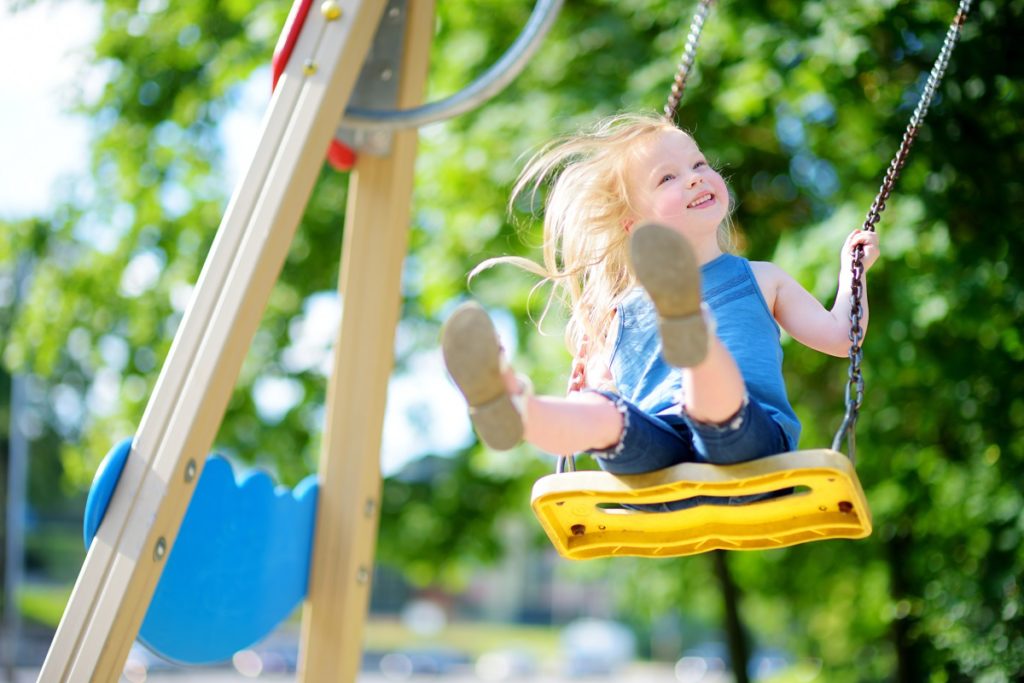Are the bodies of children who attend religiously affiliated preschools any less deserving of safety and protection on the playground than those of children who attend preschools with no religious affiliation? Tomorrow the Supreme Court of the United States will consider that question. The Court should strongly protect religious liberty and, in so doing, help safeguard the developing bodies of children on the playground equally—regardless of their religious status.
Oral argument is scheduled for tomorrow in the case of Trinity Lutheran Church of Columbia v. Comer. Trinity Lutheran operates a child learning center in Columbia, Missouri, caring for an average of ninety preschool-aged children at any given time. The great majority of those children do not otherwise attend the church. The Trinity Lutheran Child Learning Center provides a profound benefit to the community at large by supplying a quality developmental environment, grounded in the faith of its operators, where children from numerous families of various religious backgrounds (or no religious background) are able to learn and thrive.
The surface of the Learning Center’s playground was composed of pea gravel. Several years ago, the center decided to install a new, softer, more forgiving surface. Through the Learning Center, Trinity Lutheran sought a grant from the Missouri Department of Natural Resources Solid Waste Management Program to participate in the 2012 Playground Scrap Tire Surface Material Grant Program. The grant program provides a partial reimbursement grant for the specific purpose of using recycled tires to install pour-in-place rubberized surfaces on playgrounds.
The Learning Center met the criteria of the grant program so well that its application score ranked fifth out of forty-four applicants. The Missouri department awarded fourteen grants for the 2012 grant program. Therefore, according to the department’s own assessment of merit and deservedness, one of those grants should clearly have been awarded for the purpose of resurfacing the Learning Center’s playground.
However, the department did not award the grant, claiming that the Missouri Constitution prevented it from doing so—solely because of the Learning Center’s affiliation with Trinity Lutheran Church.
Start your day with Public Discourse
Sign up and get our daily essays sent straight to your inbox.Denial of Grant Funding Was Based on Religious Discrimination
According to the Missouri Department of Natural Resources, a child learning center playground is disqualified from participating in an otherwise neutrally available government grant funding program simply because it is connected to a church. In reality, this means that the Learning Center is being singled out for discrimination based on its religious status.
By refusing to provide a grant to Trinity Lutheran Church for its Learning Center playground, Missouri actually disfavors religion and turns religion into a marginalized class. The result of this religious discrimination is to redirect funds that would have gone to the Learning Center’s playground to another applicant’s implementation that, according to the Missouri department’s own criteria, serves the safety and welfare interests of the grant program less effectively.
Even more unfairly, the grant program is funded through a fee paid by purchasers of new tires in Missouri, whether the tire purchasers are religious or not. So, people of religious faith are required to pay a fee that supports the grant program, but they are barred from enjoying the benefits of that program if they enroll their children in a religiously affiliated child learning center or preschool.
Children Are Being Denied Equal Protection from Traumatic Brain Injuries
This issue is not simply an academic matter of dealing with state-facilitated disrespect for religion and for organizations affiliated with religious faith. Nor is it simply a matter of requiring children who use the Learning Center’s playground to endure the minor discomforts of scraped knees and elbows they may otherwise have avoided. It is also about providing equal protection to children against very hazardous traumatic brain and head injuries that are particularly likely to occur on playgrounds.
Copious research reflects the significant, widespread danger of serious cranium-related injuries children suffer on playgrounds. Those injuries are more likely to occur on playgrounds that do not feature the latest improvements in soft-surface technologies. The decision by the Missouri Department of Natural Resources to deny reimbursement grant funding for the Learning Center’s playground makes the children who attend the Learning Center more susceptible to serious brain trauma resulting from playground accidents.
These concerns are not purely theoretical. A May 2016 study by multiple researchers and published in Pediatrics—which has been cited in material published by the Centers for Disease Control and Prevention of the US Department of Health and Human Services—examined US playground injury rate data from 2001 to 2013. The study presented some startling and sobering statistics. It found an annual average of more than 214,000 individuals age fourteen or younger were treated in emergency departments (“EDs”) for playground-related injuries. Nearly 10 percent—on average, more than 21,000 per year—of those emergency department visits involved treatment for traumatic brain injury (“TBI”). The study reported that “the annual rate of TBI ED visits increased significantly from 2005 to 2013,” and concluded: “Strategies to reduce the incidence and severity of playground-related TBIs are needed” and “may include . . . improvements in playground surfaces and environments” (emphasis added). In short, “Modern playground surfaces reduce the risk of death or serious injury due to falls.”
It bears emphasizing that the study reports that the risks associated with playground-related falls are not confined to minor types of injuries but encompass dangerous traumatic brain injury as well as severe head and neck injuries—some of which can even lead to death. Moreover, the study concludes:
TBIs, even those categorized as mild, can have serious implications for the physical, cognitive, and behavioral health of children, including physical impairments, lowered cognitive skills, and deficits in behavioral and adaptive functioning. These problems can lead to further consequences, such as disability, academic failure, and social isolation. Studies suggest that even children with mild TBI are at risk for disability because of psychosocial effects that require specialized resources to return to community living. Therefore, understanding the epidemiology and trend of playground-related TBI is necessary to guide strategies to reduce the occurrence of this injury.
The study has been cited by news outlets such as ABC News (which noted the study’s observation that improvements in playground surfacing can help lower TBI) and CBS News (which noted the significant increase in recent years in playground-related traumatic brain injuries and the importance of soft surfacing in reducing them).
Accordingly, a recent, comprehensive study underscores the absolute importance of protecting children from traumatic brain injury on playgrounds. The same study focuses on ensuring proper playground surfacing as a key way to accomplish that goal. The need for softer playground surfaces to keep children safe is further emphasized by the Centers for Disease Control and Prevention, which exhorts parents in its Playground Safety Tips for Parents brochure to “Check that playgrounds have soft material under them.”
The results found in recent research and the safety advice distributed by the Centers for Disease Control and Prevention are reflected in common sense and experience. Falling on a pliable, cushioned, rubberized surface is clearly preferable to falling on rocks. As one example, a 2016 CBC News report describing the aforementioned study reflected one parent’s very practical assessment of the benefits of rubberized playground surfaces:
At a playground in Toronto, Garrick Lau appreciated the newer rubber surfaces.
“Our little one just sort of bounced off this ground,” Lau said. “I think she was more scared from the fall. But the impact didn’t hurt her at all so that’s great.”
All Children Deserve Safe, Fair Play
The bodies and brains of some children should not be subjected to potentially severe playground injuries simply because their child learning center is religiously affiliated. All children are equally valuable. Their bodies and brains are equally deserving of protection, regardless of their religious status. Few would disagree with that.
By extension, state-administered grant money should be awarded based on merit—in accordance with the health and welfare aims of the particular program—not based on religious affiliation or belief. If the Missouri Department of Natural Resources is permitted to exclude a religiously affiliated child learning center from the grant program solely because it is connected to a church, it will have been given a license to discriminate based on religion. The religion clauses of the First Amendment and the Equal Protection Clause of the Fourteenth Amendment to the US Constitution certainly do not countenance such a pernicious result.
All children deserve equal opportunities to be kept safe on the playground—whether the playground is at a community preschool with no religious association or at a religiously affiliated preschool. The Supreme Court should seize the opportunity it has in the Trinity Lutheran case to halt religious discrimination against religiously affiliated child learning centers and ensure equal protection and safety on playgrounds for all children, regardless of their religious status. Only then will all children be assured both safe play and fair play.













